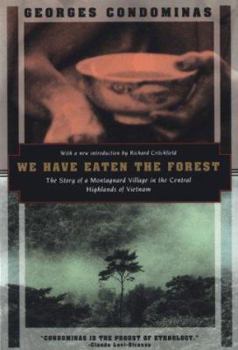We Have Eaten the Forest: The Story of a Montagnard Village in the Central Highlands of Vietnam
Select Format
Select Condition 
Book Overview
International in scope, this series of non-fiction trade paperbacks offers books that explore the lives, customs and thoughts of peoples and cultures around the world. This is the story of a... This description may be from another edition of this product.
Format:Paperback
Language:English
ISBN:1568360231
ISBN13:9781568360232
Release Date:January 1994
Publisher:Kodansha
Length:464 Pages
Weight:1.15 lbs.
Dimensions:1.2" x 5.7" x 8.4"
Customer Reviews
1 rating
Requiem...
Published by Thriftbooks.com User , 14 years ago
Georges Condominas originally published this ethnographic work on the Montagnards of the Central Highlands of Vietnam in French, in 1957. It took over 20 years for an authorized English language version to be produced, and in the introduction to that work Condominas notes that none other than the United States Department of Commerce produced a pirated copy of his work, in English, in 1962. As he said, he was certain that they did not have deep scientific concerns, but rather produced it for political and military reasons, without consulting him or his French publisher. America's concern for "intellectual property rights" sometimes is ambivalent when it is someone else's property. Condominas, who was born in Vietnam, conducted his study during a very narrow window of relative peace in the area, 1948-49, when the French were struggling to retain control of their colonial possession, and most of the fighting was in the northern part of the country. He went to the small village of Sar Luk, with a population of 148, located between Ban Me Thuot and Dalat. The book is a dense ethnographic work, and as he says in the 1955 introduction, it is "simple raw materials... with no attempt on my part to establish a sociological structuring or to compromise the material with literary embellishments." Thus the reader is treated to an exchange of buffalo sacrifices, to a case of incest and suicide, and the subsequent exorcism of the violent death, and to the issues involving the afterlife. As a work of sociology, during his 15 month stay in the village, he also described a wedding, a birth, a natural death, and the celebrations during their many holidays (alas, far more than we seem to be allocated in the West), along with their affection for rice wine. There is a 10 page glossary of Mnong Gar terms, which are interspersed throughout the text, making the reading somewhat of a slog. The title refers to their name, which relates to their "slash and burn" agricultural policies, of burning a portion of the forest, growing a crop, then moving on to another area, doing the same, and rotating this maybe every 20 years. He relates that he conducted his study before the time of small, portable tape recorders, and his only "instrument" was a small camera that he begged. He put it to excellent use, and the photographs throughout the book are a poignant testament to a vanished people, and way of life. The book is not for the "fun read" crowd. You'd have to have a "special interest," either as an aspiring ethnographer researching the work of a leader in the field, or more prosaically, having been in the Central Highlands, and marveled at these people. My case was the later, and although I was assigned to a tank unit in the 4th Division, I had to go out with the infantry for 9 days, and on one such mission we walked into one of these villages, grateful for the lack of hostility (or hostile actions), and we exchanged some C-Rations for their bananas. Since I was the medic, v




